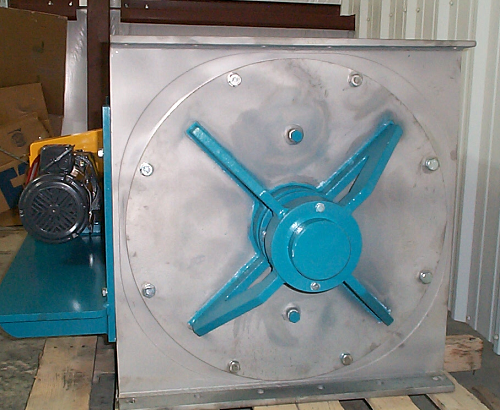We Repair Leaking Rotary Airlock Valves
Streamline Industries specializes in repairing leaky rotary airlock valves.
Rotary airlocks, also called rotary feeders or rotary valves, are used for different applications in industries such as agriculture, mining, plastics, food, chemical and construction materials. As a key component of a material handling system, rotary airlock valves are used to control the amount of dry, free-flowing granules, pellets or powders that can enter the system at one time.

Although often thought of as a “commodity” product, there are definitely certain configurations that will work better with one type of material than another. Considered one of the simplest of machines, with only one moving part, rotary airlock valves consist of either a closed or open vaned rotor revolving in close contact to the valve housing, with an inlet on one side of the housing and outlet on the other.
Blow-Through and Drop-Through Rotary Valves
The two most common types of rotary valves are blow-through valves and drop-through valves.
As you may guess, the primary difference between the two types of valves is that one is designed to operate in a pressurized environment while the other relies on gravity. Both valves work well to control materials travelling from one chamber to another while also maintaining a good airlock between the two.
A blow through rotary airlock is connected on both sides of the end plate and is commonly used as pneumatic conveyor valve for dry powders, dust extraction and industrial vacuum systems.
Drop through rotary valve relies on gravity to introduce a predetermined amount of generally dry, powdery or granular bulk material into a convey line.
Most of the issues that we experience in the field can be traced back to the choices someone made about the type of rotary valve to use and the features selected for it.
‘Airlocks’ are not Air Seals
It’s a bit of a misnomer to call these valves “airlocks” since, by design, all rotary valves leak air when the system is operating. To operate correctly, there must be some clearance between the rotor blades and the housing. Also, when material enters into the rotor chamber, it displaces the air that was previously occupying the space.
Since some air leakage is inevitable, it’s important to factor this into the design of the system and take the appropriate measures to minimize it. Blow-through or blowing seals are also an important part of the equation to maintain a highly efficient system with minimal loss of pressure.
Here are a few of the other ways that Streamline Industries works with our customers to design new systems and troubleshoot underperforming ones.
- Attach the rotary airlock directly to the container. When the rotary airlock valve is connected directly to the vessel, it acts as an airlock and metering device. This is the simplest method in resolving air leakage.
- Install a vented surge hopper. The use of surge hopper with a dedicated vent filter to the rotary airlock valve is an effective way of directing air leakage back into the atmosphere. However, it’s critical to follow a regular cleaning schedule to prevent clogged vent filters from negatively impacting performance.
- Add a vent pipe to the top of the vessel. Here, a vented surge hopper without a (dedicated vent filter) is used to direct air up and out of the top of the container without being reintroduced to the materials. Instead of a filter a vent pipe, hopper vent stub and fan is added to the unit.
- Create a central dust collection. Using a vented hopper, this system prevents air leakage by collecting dust through a centralized system. The system uses the air volume produced by the fans of the dust collector, not the leakage air to operate. This system is most appropriate for low value materials that can be collected (with outside dust and debris) and disposed of as waste.
- Install an eductor to capture air leaks. An eductor can be installed in the vent pipe to capture, rather than vent air leakage. Using this approach will allow the appropriate level of air to remain in the system in order to consistently move heavier materials.
- Add an airlock body/boss vent. Create two airlock sources by installing a body vent or boss vent to the system. This method allows empty rotor pocket to remain pressurized, eliminating air leaking through the rotor blade-to-housing clearance space.
Conclusion
So what’s the best solution? That’s for us to find out together. Our staff at Streamline Industries includes some of the most experienced and knowledgeable professionals in the industry. We work closely with each one of our customer to meet their unique needs.
The best solution for your operation is the one designed to deliver consistent, reliable performance as efficiently as possible.
